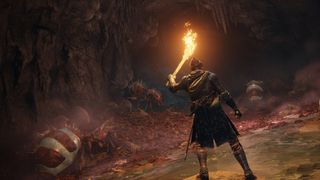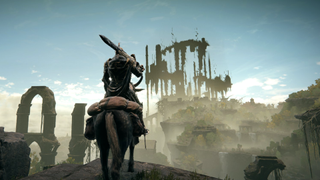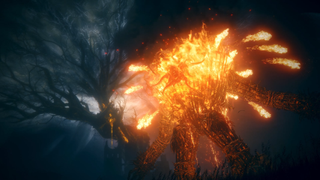Difficulty’s got nothing to do with it.

(Image credit: FromSoftware)
Soulslikes—that is, the genre of games loosely defined by their similarities to FromSoftware’s Dark Souls and Demon’s Souls—are pretty common nowadays. Turns out that thoughtful and deliberate combat, challenging difficulty, and solid RPG mechanics are a good set of ingredients for a game.
I played quite a few last year—I played Lies of P, Remnant 2, and I reviewed Lords of the Fallen as well. They’re all pretty dang good games in their own right, with Remnant 2 feeling like the most inventive of the bunch, what with tying the knot between ARPG mechanics and the soulslike secret sauce.
What I realised, however, in my recent playthrough of the Elden Ring DLC Shadow of the Erdtree, is this: No one quite does an ambush like FromSoftware.
Most mechanics pulled out of FromSoftware’s cauldron are, on paper, time-consuming but straightforward to replicate. A responsive dodge roll with some sort of invincibility frames, a limited healing resource, bonfire-like checkpoints—all can, as evidenced by those games, be reproduced without too much trouble.
That’s not to say making those moving parts sing is easy, mind, but from a design perspective, they can be imitated. How many frames of an animation should have invincibility? Study the animations, read some analysis from the wunderkind dataminers who study these sorts of things. How many bonfires should you have? Boot up an old souls game and spend some hours measuring the average distance between, and keep it in mind as a guide. The ambush, though, is far trickier to replicate.
Why are we here, just to get jumped?

(Image credit: FromSoftware / BonfireVN on YouTube.)
First, I feel like I should define what I mean by an “ambush”: Simply put, it’s the bastard around the corner. It’s the guy hidden under a bunch of crates. It’s the gargoyle/goblin/bird/slime that drops on you from the ceiling. The kind of encounters that condition you to peek around every corner with your shield raised or your thumb lingering over the dodge roll button.
Some soulslike games, particularly Lords of the Fallen (though its developer made attempts to tone things down after I played it) make the crucial mistake of assuming that ambushes are there to make exploration difficult. ‘Soulslike games are hard, right? Ambushes make you die more while exploring, problem solved.’
I think this is a complete misunderstanding, though. Yes, an ambush makes the environment challenging and hostile—but only really once. When you know an ambush is coming in a familiar area, it becomes something you tick off on a list of chores. Charging the archer I know is there now is as mundane as hanging up my laundry.
To me, a good ambush in a soulslike should be treated like a scare in a horror movie or a game—in that, to properly get someone, you need to build up suspense. An ambush should be the sharp and sudden drop in a rollercoaster after a drawn-out, click-click-click of a passenger car on a steep incline.
Restraining thineself

(Image credit: FromSoftware)
FromSoftware games are, despite appearances, actually content to go ages without so much as an ooga or a booga. Shadow of the Erdtree specifically seemed to have a master’s touch, rewarding my paranoia just often enough that I never quite felt comfortable entering a room without my guard up. It had the restraint to not put a bugger behind a box every 10 feet.
Creating this sense of paranoia does wonders for making a FromSoftware game feel hostile without making it feel annoying—I’m pretending Blighttown doesn’t exist, admittedly. It helps you pay far closer attention to your surroundings. Not because you know there’ll be something just around the corner, but because you know there might be. The devil you don’t (know) has hands.
Gallivanting around the Land of Shadow, I was also struck by just how quiet FromSoftware was willing to let things get. Especially in areas like the Shaman Village—where a lesser developer might’ve put a miniboss, but no. Sometimes, there’s just no threat. When you let your guard down, too, you aren’t always punished—which makes it more effective when you are.
It’s a fascinating contradiction that a studio so often known for terrifying difficulty spikes is often the first to scrap difficulty in favour of atmosphere. Mind, this doesn’t always work. Erdtree’s finger ruins, for example, were a little frustrating—mostly because FromSoftware is just as willing to hide a super important cave with a weapon, incantation, and talisman you really want behind its alien superstructures, and there was just never anything there.
Regardless, none of the soulslikes I played in 2023 ever quite managed this level of mastery. Their ambushes often seemed randomly placed, made to trick rather than treat:

(Image credit: FromSoftware)
Lords of the Fallen, as mentioned, had a chronic issue on release with putting a gremlin around every corner. Every single time there was an opportunity for an ambush, chances are there was one—and it overstayed its welcome quickly.
Remnant 2 meanwhile literally had randomly generated ambushes, though I don’t hold it against that game since that’s the entire conceit, with its procedurally arranged setpieces and ARPG stylings. It also did a great thing by kicking each ambush off with a terrifying musical sting that often reached you before the enemy did—making you scramble to check your corridors and listen for footsteps.
Lies of P came the closest to replicating FromSoftware’s pacing—and it certainly didn’t skimp on atmosphere—but still, I never had that ‘false sense of security’ feeling creep in the same way.
Still, I am looking forward to the game that finally gets this most slippery of design tricks right. I still had a great time with each one of these titles—I said as much back then—and given FromSoftware’s propensity for two-year releases, I’m sure we’ll get a good dousing of determined imitators next year, if not this one, with games like Flintlock: The Siege of Dawn and Black Myth: Wukong on the horizon.

